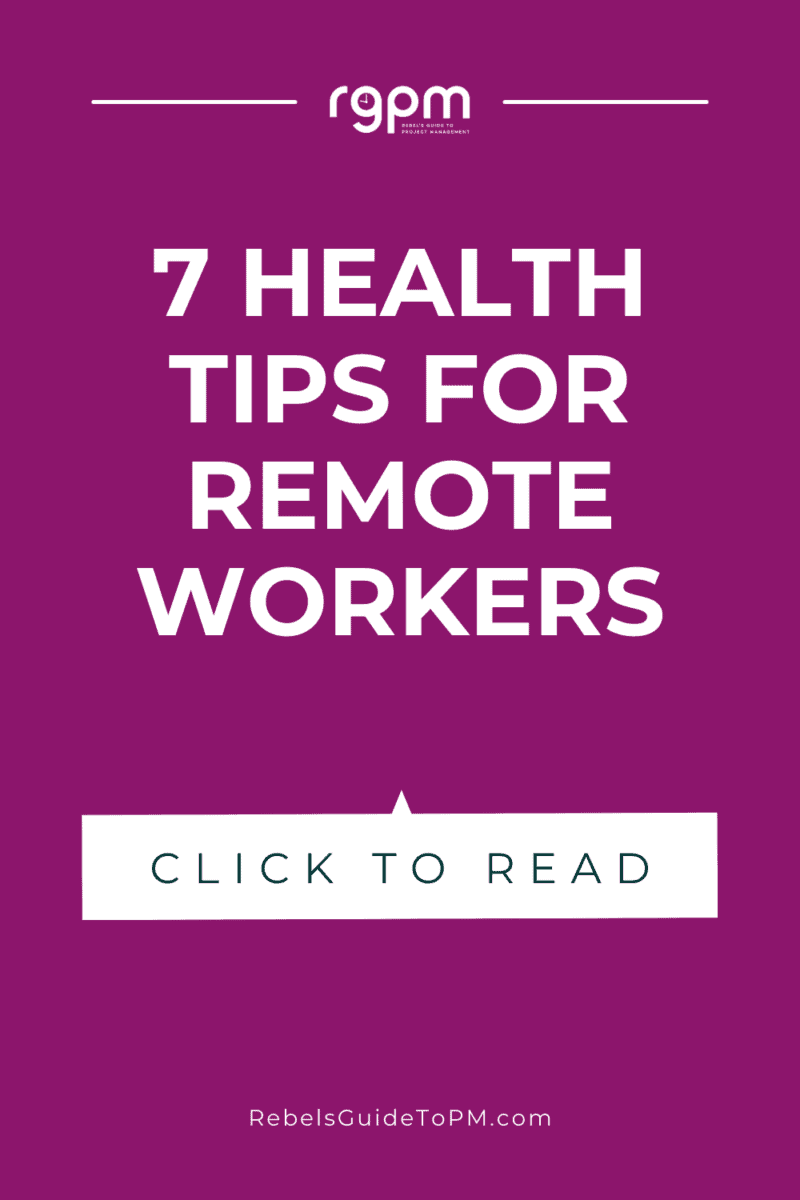7 Health tips for remote workers
Hybrid employees go into the office 2-3 days a week on average, according to research by Owllabs. That makes most of us remote for at least some of the time.
Yes, there is a drive to get more people back in the office: the great power shift is seeing the presence of more and more employees being requested back in the office, but spending at least some of your week in the spare room or at the kitchen table is here to stay.
Project-based work is perfectly suited to working from home because you can do pretty much everything you need from a laptop, so you can be based anywhere. And plenty of other jobs fit the same model.
There are lots of benefits (for workers) associated with remote work, including no commute, reduced non-essential meetings, and fewer distractions in the office. Employers also see reducing risk as a benefit. In my article on how to convince your boss to go (or stay) remote, I shared research on how 73% of managers reported reduced risk with flexible work, as employees can work regardless of bad weather, illness, and various other factors.
Still, despite remote work losing its novelty, many employees and employers overlook the impact of flexible work on one’s physical and mental health. Have you ever gone through the motions on your mandatory training and ticked all the boxes on your Display Screen Equipment assessment without really analyzing your workplace and what might improve it? (I’m not saying I have but…)
Below, we’ll look at some essential health tips for remote workers to keep their health in top shape.

1. Create a morning routine
And I don’t mean check your phone before you get out of bed! (Although I’m guilty of that too, pressing it up close to my face as without my glasses I can’t read the screen.)
Healthy habits are easier to follow if they are routine. If you can stomach it, factor some physical activity into your morning.
Fit in some social interaction too, so make breakfast family time with the kids, or check in with relatives by sending a quick message. I find it’s easier to settle into the work day if I feel my personal commitments are already taken care of.
2. Caring for eye health
An often underestimated aspect of physical health is our eye health. As of 2018, over two million people in the UK have vision loss, more than half of which is preventable. Up to one-third of working-age people suffer from severe visual impairment and are unfortunately unemployed. Obstacles to productivity are costing the British economy up to £7.4 billion.
Caring for your eye health by buying blue light glasses to alleviate eye strain from digital screens and blue light can help you focus for longer without getting distracted or experiencing visual discomfort.
As your eyes tend to work overtime when working remotely, you should consider investing in good lighting or working near your window for natural light. Taking routine breaks will also provide much-needed rest for your eyes.
Use your employer benefits to get free eye tests if you are display screen equipment user, and as you’re reading this on a screen, you probably qualify. That’s a benefit for UK employees – so if you aren’t based in the UK, check out what equivalent or similar benefits are on offer to you through your employer.
3. Get some exercise
Fit regular exercise into your remote life. It should be easier to do: some brisk housework while you rush around at lunchtime, a quick walk round the block at lunch time.
I count using my standing desk of a bit of light relief from my sedentary lifestyle of sitting on my backside on calls most of the day, so I’m grateful to have the option of raising it up at the touch of a button.
I have not ever considered a treadmill desk, but you do you.
4. Eating healthily (and regularly)
Working remotely is often a time-management challenge. Between virtual meetings, responding to emails, and completing work tasks, you might forget to eat or simply skip your well-deserved lunch break.
However, nutritionists say skipping meals makes it difficult to meet your nutritional needs for the day, leading to lowered metabolism and an increased risk of nutrient deficiencies.
Skipping meals can also lead to unhealthy cravings, causing you to choose less healthy food options later in the day. Not eating enough throughout the day can also impact your energy levels and, in turn, your productivity, as you become subject to increased irritability, moodiness, and a lack of motivation.
Get in some healthy snacks that are accessible to you while working at your desk, like fruits and oat bars, cheese and nuts. I’m favoring roasted chick peas at the moment. Take regular breaks, but don’t snack all day.
I prep healthy lunches at the weekend and then freeze them for the week. It does mean that I eat the same lunch pretty much every day for a week, but if I was more organized I’d have two or three weeks of batched food and I could mix and match. At the moment, it’s a vegetable risotto.
5. Invest in ergonomics
Recently, I bought a very expensive chair for my home office, and it’s great. My old chair wasn’t bad and had lasted around 20 years and several house moves.
However, expensive doesn’t always equal comfy: I tried out several in the shop that were expensive but didn’t seem to fit me at all.
Another overlooked health aspect for remote workers is ergonomics. Ergonomics can impact your posture, productivity, and physical health in the long term. Research has shown that investing in an ergonomic chair guarantees between 15% and 20% more productivity.
An optimized ergonomic workspace can help you work more comfortably and free from distractions and discomfort. You probably know the drill: monitor at eye level, avoid poor posture, use an external keyboard to avoid muscle strain
Instead of working from your bed or a sofa, invest in a decent office chair and a dedicated workspace set up just for you.
6. Practice mindfulness
Finally, keeping yourself grounded and in the present can help you become more aware of your thoughts and feelings. Don’t discount this!
Practicing mindfulness has been shown to help with many conditions, including stress, anxiety, depression, and physical health problems like hypertension, heart disease, and chronic pain.
Fortunately, you don’t have to spend much money to start. While you can opt for group mindfulness courses or coaching, you can do self-directed practice at home via e-books, audiobooks, and mindfulness apps.
I use the Finch app (get in touch if you want to join my Treehouse!) which starts each day with affirmations and also has reminders for achieving your goals. My goals at the moment are drinking water and a couple of minutes of exercise but you could choose other healthy habits you want to incorporate into your day.
There are also simple one-minute mindfulness exercises for breathing and body scanning to bring awareness to your body and sensations. These are known to be calming, which can be helpful in stressful work situations.
7. Look out for other remote employees
Physical health aside, it’s worth looking out for the wellbeing of other remote employees. Check in with your colleagues with messages or on calls. Make small talk. Be slow to start team meetings if people are talking about the weekend.
These small connections are so important to help us feel like work time is not just screen time: it’s also a way to connect with others and do valuable, meaningful work.
What other tips do you have for staying healthy as a remote employee? Find me on LinkedIn or come over to our Facebook group, Project Management Cafe and share your ideas! We’d love to hear from you.
Pin for later reading

